How resistance depends on temperature
In his practice, every electrician encounters different conditions for the passage of charge carriers in metals, semiconductors, gases and liquids. The magnitude of the current is affected by the electrical resistance, which changes in various ways under the influence of the environment.
One of these factors is exposure to temperature. Since it significantly changes the conditions of current flow, it is taken into account by designers in the manufacture of electrical equipment. Electrical personnel involved in the maintenance and operation of electrical installations must competently use these functions in practical work.
Effect of temperature on the electrical resistance of metals
In the school physics course, it is proposed to conduct such an experiment: take an ammeter, a battery, a piece of wire, connecting wires and a torch. Instead of an ammeter with a battery, you can connect an ohmmeter or use its mode in a multimeter.
Next, you need to assemble the electrical circuit shown in the picture and measure the current in the circuit.Its value is indicated on the milliammeter scale by a black arrow.
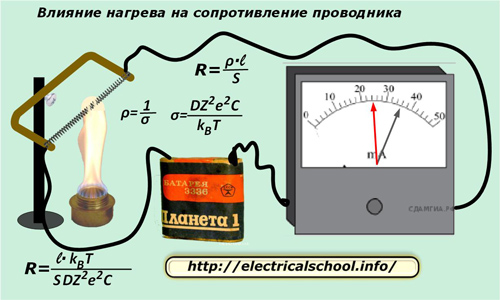
Now we bring the flame of the burner to the wire and begin to heat it. If you look at the ammeter, you will see that the needle will move to the left and reach the position marked in red.
The result of the experiment shows that when metals are heated, their conductivity decreases and their resistance increases.
The mathematical justification of this phenomenon is given by the formulas right in the picture. In the lower expression it is clearly seen that the electrical resistance «R» of the metal conductor is directly proportional to its temperature «T» and depends on several other parameters.
How heating metals limits electric current in practice
Incandescent lamps
Every day when the lights are turned on, we encounter the manifestation of this property in incandescent lamps. Let's perform simple measurements on a 60 watt bulb.
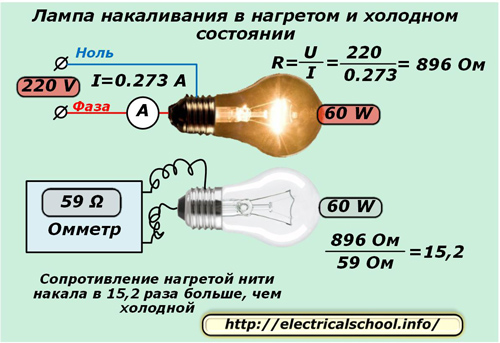
With the simplest ohmmeter, powered by a 4.5 V low-voltage battery, we measure the resistance between the contacts of the base and see the value of 59 ohms. This value is owned by a cold thread.
We will screw the bulb into the socket and connect to it through the ammeter the voltage of the home network of 220 volts. The ammeter needle will read 0.273 amps. From Ohm's law for a section of a circuit determine the resistance of the thread in the heated state. It will be 896 ohms and exceed the previous ohmmeter reading by 15.2 times.
This excess protects the metal of the luminous body from burning and destruction, ensuring its long-term operation under voltage.
Power-on transients
When the thread is working, a thermal balance is created on it between the heating by the passing electric current and the removal of part of the heat to the environment. But in the initial stage of switching on, when voltage is applied, transients occur, creating an inrush current, which can cause the filament to burn out.
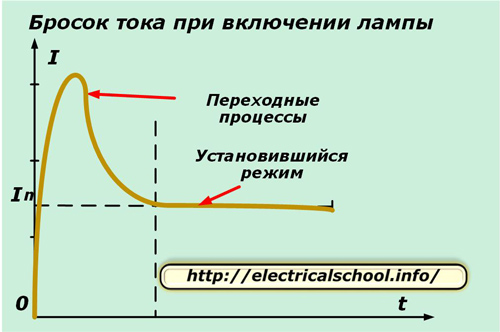
Transient processes occur for a short time and are caused by the fact that the rate of increase in electrical resistance when heating the metal does not keep pace with the increase in current. After their completion, the mode of operation is established.
When the lamp shines for a long time, the thickness of its filament gradually reaches a critical state, which leads to burning. Most often, this moment occurs at the next new switch on.
To extend lamp life, this inrush current is reduced in various ways using:
1. devices providing smooth supply and release of tension;
2. circuits for series connection to a filament of resistors, semiconductors or thermistors (thermistors).
An example of one way to limit the inrush current for automotive lighting fixtures is shown in the photo below.
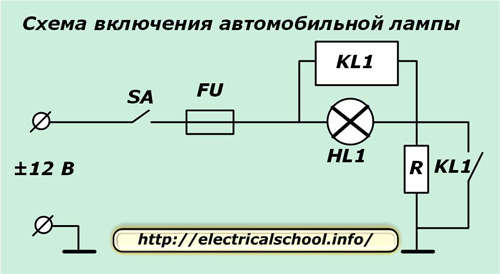
Here the current is supplied to the bulb after the switch SA is turned on through the FU fuse and is limited by the resistor R, the nominal value of which is chosen so that the inrush current during transients does not exceed the nominal value.
When the filament is heated, its resistance increases, which leads to an increase in the potential difference between its contacts and the parallel-connected coil of the KL1 relay.When the voltage reaches the relay setting value, the normally open contact of KL1 will close and bypass the resistor. The operating current of the already established mode will begin to flow through the bulb.
Resistance thermometer
The effect of the temperature of the metal on its electrical resistance is used in the operation of measuring instruments. They are called resistance thermometers.
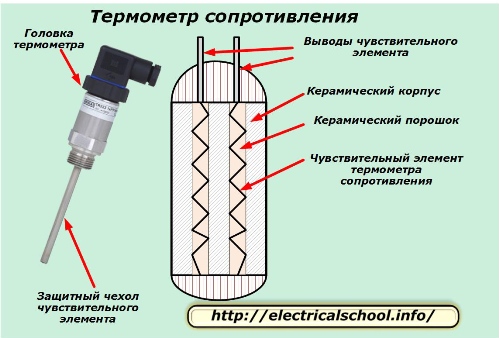
Their sensitive element is made with a thin metal wire whose resistance is carefully measured at certain temperatures. This thread is mounted in a housing with stable thermal properties and covered with a protective cover. The created structure is placed in an environment whose temperature must be constantly monitored.
The conductors of the electrical circuit are mounted on the terminals of the sensitive element, which connect the resistance measurement circuit. Its value is converted to temperature values based on the previously performed calibration of the device.
Barretter — current stabilizer
This is the name of a device consisting of a glass sealed cylinder with hydrogen gas and a spiral of metal wire made of iron, tungsten or platinum. This design resembles an incandescent light bulb in appearance, but has a specific non-linear current-voltage characteristic.
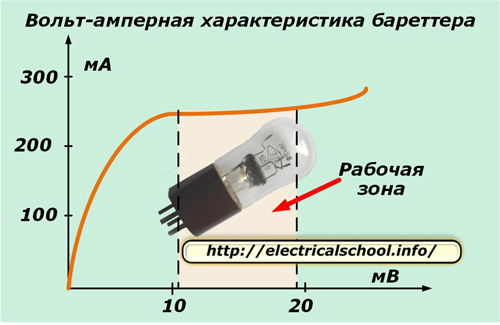
On the I — V characteristic, in a certain range of it, a working zone is formed, which does not depend on the fluctuations of the voltage applied to the heating element. In this area, the baret compensates the power supply ripple well and works as a current stabilizer for a load connected in series with it.
The operation of the barrette is based on the properties of the thermal inertia of the filament body, which is provided by the small cross-section of the filament and the high thermal conductivity of the hydrogen that surrounds it. Therefore, when the voltage of the device decreases, the removal of heat from its filament accelerates.
This is the main difference between incandescent lamps and incandescent lamps, where in order to maintain the brightness of the glow, they seek to reduce the convective heat loss from the filament.
Superconductivity
Under normal ambient conditions, when a metal conductor cools, its electrical resistance decreases.
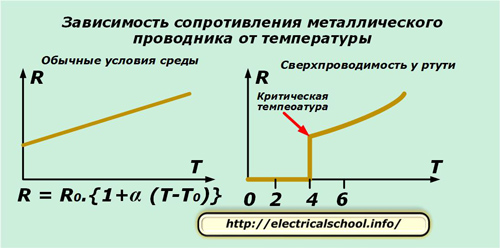
When the critical temperature is reached, close to zero degrees according to the Kelvin measurement system, there is a sharp drop in resistance to zero. The right picture shows such a dependence for mercury.
This phenomenon, called superconductivity, is considered a promising area of research in order to create materials that can significantly reduce the loss of electricity during its transmission over long distances.
However, continuing studies of superconductivity reveal a number of patterns where other factors affect the electrical resistance of a metal in the critical temperature region. In particular, when alternating current passes with an increase in the frequency of its oscillations, a resistance occurs, the value of which reaches the range of normal values for harmonics with a period of light waves.
Effect of temperature on the electrical resistance / conductivity of gases
Gases and normal air are dielectrics and do not conduct electricity.Its formation requires charge carriers, which are ions formed as a result of external factors.
Heating can cause ionization and movement of ions from one pole of the medium to another. You can check this with the example of a simple experiment. Let's take the same equipment that was used to determine the effect of heating on the resistance of a metal conductor, but instead of a conductor, we connect two metal plates separated by an air space to the conductors.
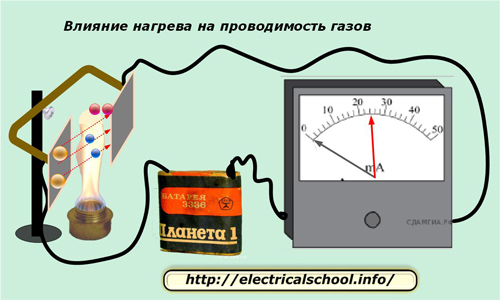
An ammeter connected to the circuit will show no current. If the flame of the burner is placed between the plates, the arrow of the device will deviate from zero and show the value of the current passing through the gas medium.
Thus, it was found that ionization occurs in gases when heated, which leads to the movement of electrically charged particles and a decrease in the resistance of the medium.
The value of the current is affected by the power of the external applied voltage source and the potential difference between its contacts. It is capable of breaking through the insulating layer of gases at high values. A typical manifestation of such a case in nature is the natural discharge of lightning during a thunderstorm.
An approximate view of the current-voltage characteristic of the current flow in gases is shown in the graph.
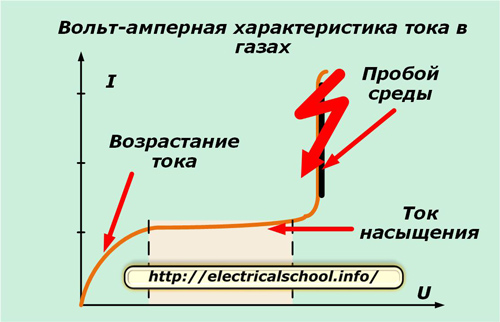
In the initial stage, under the influence of temperature and potential difference, an increase in ionization and the passage of current is observed approximately linearly. The curve then acquires a horizontal direction when an increase in voltage does not lead to an increase in current.
The third stage of destruction occurs when the high energy of the applied field accelerates ions so that they begin to collide with neutral molecules, massively forming new charge carriers from them. As a result, the current increases sharply, forming a breakdown of the dielectric layer.
Practical use of gas conductivity
The phenomenon of current flow through gases is used in radio-electron lamps and fluorescent lamps.
For this purpose, two electrodes are placed in a sealed glass cylinder with an inert gas:
1. anode;
2. cathode.
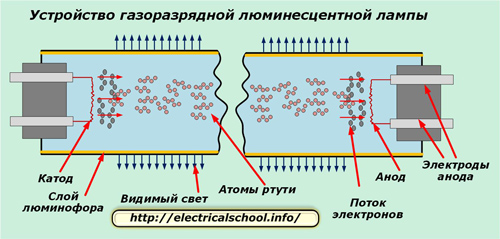
In a fluorescent lamp, they are made in the form of filaments that heat up when switched on to create thermionic radiation. The inner surface of the flask is coated with a layer of phosphorus. It emits the visible spectrum of light formed by infrared radiation emitted by mercury vapor bombarded by a stream of electrons.
The discharge current occurs when a voltage of a certain value is applied between the electrodes located at different ends of the bulb.
When one of the filaments burns out, then the electron emission of this electrode will be disturbed and the lamp will not burn out. However, if you increase the potential difference between the cathode and the anode, then a gas discharge will again appear inside the bulb and the phosphor luminescence will resume.
This allows the use of LED bulbs with damaged filaments and extending their service life. It should only be borne in mind that at the same time it is necessary to increase the voltage on it several times, and this significantly increases the energy consumption and the risks of safe use.
Effect of temperature on the electrical resistance of liquids
The passage of current in liquids is created mainly due to the movement of cations and anions under the action of an external electric field. Only a small fraction of the conductivity is provided by electrons.
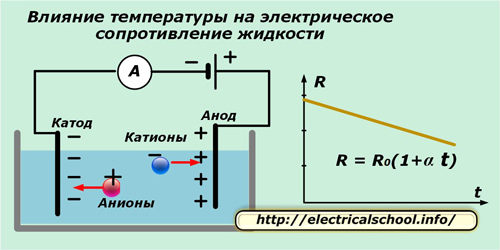
The effect of temperature on the electrical resistance of a liquid electrolyte is described by the formula shown in the picture. Since the value of the temperature coefficient α in it is always negative, then as the heating increases, the conductivity increases and the resistance decreases, as shown in the graph.
This phenomenon should be taken into account when charging liquid automotive (and not only) batteries.
Effect of temperature on the electrical resistance of semiconductors
Changing the properties of semiconductor materials under the influence of temperature made it possible to use them as:
-
thermal resistance;
-
thermocouples;
-
refrigerators;
-
heaters.
Thermistors
This name means semiconductor devices that change their electrical resistance under the influence of heat. Theirs temperature coefficient of resistance (TCR) significantly higher than that of metals.
The TCR value for semiconductors can be positive or negative. According to this parameter, they are divided into positive «RTS» and negative «NTC» thermistors. They have different characteristics.
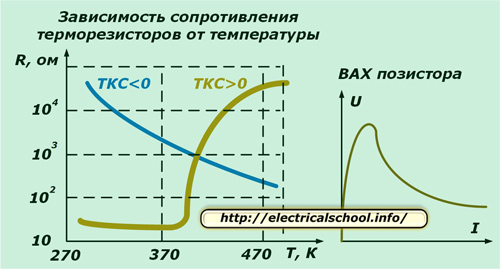
For the operation of the thermistor, one of the points of its current-voltage characteristic is selected:
-
linear section is used to control temperature or compensate for changing currents or voltages;
-
the descending branch of the I — V characteristic of elements with TCS <0 allows the use of a semiconductor as a relay.
The use of a relay thermistor is convenient for monitoring or measuring electromagnetic radiation processes occurring at ultrahigh frequencies. This ensures their use in systems:
1. heat control;
2. fire alarm;
3. regulation of the flow rate of bulk media and liquids.
Silicon thermistors with a small TCR > 0 are used in cooling systems and temperature stabilization of transistors.
Thermocouples
These semiconductors work on the basis of the Seebeck phenomenon: when the solder joint of two dispersed metals is heated, an EMF occurs at the junction of a closed circuit. In this way, they convert thermal energy into electrical energy.
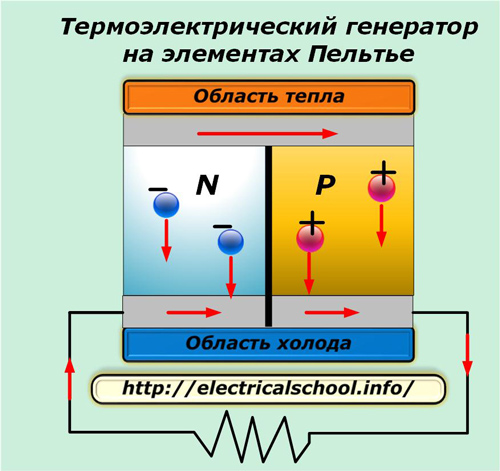
A construction of two such elements is called a thermocouple. Its efficiency is within 7 ÷ 10%.
Thermocouples are used in thermometers for digital computing devices requiring miniature size and high reading accuracy, as well as low power current sources.
Semiconductor heaters and refrigerators
They work by reusing thermocouples through which an electric current passes. In this case, in one place of the junction it is heated, and in the opposite one, it is cooled.
Semiconductor connections based on selenium, bismuth, antimony, tellurium allow to ensure a temperature difference in the thermocouple up to 60 degrees. This made it possible to create a design of a refrigerator from semiconductors with a temperature in the cooling chamber down to -16 degrees.
